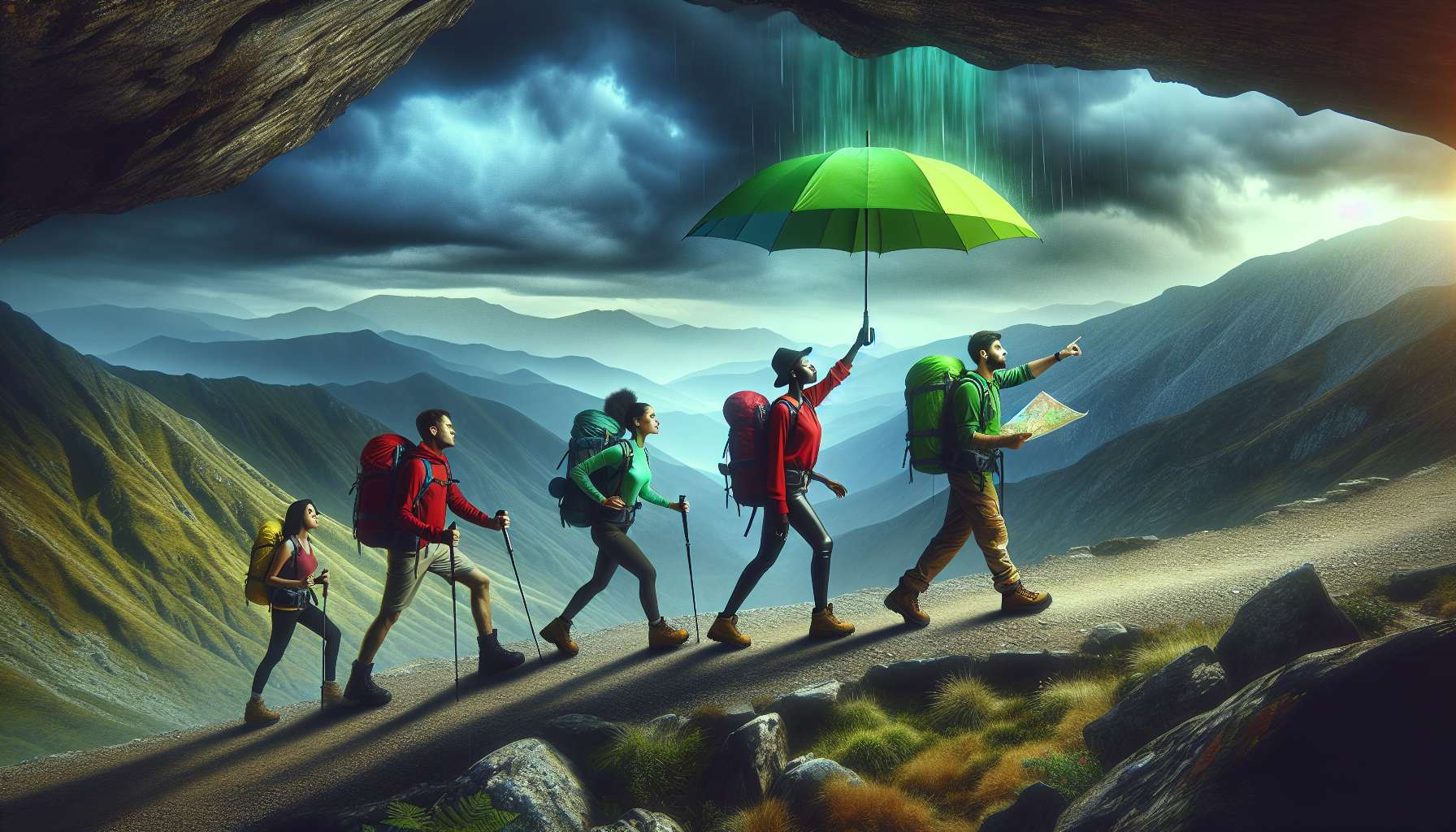Trekking Umbrellas: A Comprehensive Guide to Staying Dry on Your Adventures
Imagine you’re out in the wilderness, trekking through rugged terrains, surrounded by breathtaking landscapes. Suddenly, the clouds roll in, and rain starts pouring down. You reach for your trusty trekking umbrella, unfurl it, and continue your journey without skipping a beat. Trekking umbrellas have become an essential piece of gear for outdoor enthusiasts, offering protection from the elements while being lightweight and versatile. In this comprehensive guide, we will delve into the world of trekking umbrellas, exploring their history, benefits, uses, and much more.
The History of Trekking Umbrellas
Trekking umbrellas have a long history, dating back to traditional umbrellas used in various cultures for protection against the sun and rain. In recent years, they have gained popularity among hikers, backpackers, and outdoor adventurers for their lightweight design and ease of use. The modern trekking umbrella is typically made of durable materials such as fiberglass or aluminum for the frame and waterproof fabric for the canopy. These umbrellas are designed to withstand tough weather conditions and provide reliable protection on the trail.
One of the pioneers of trekking umbrellas is the Japanese outdoor gear company Montbell, which introduced the concept of using umbrellas for hiking in the early 2000s. Since then, several other outdoor brands have followed suit, offering their own versions of trekking umbrellas with features tailored to meet the needs of outdoor enthusiasts.
The Benefits of Using a Trekking Umbrella
There are several advantages to using a trekking umbrella in addition to or instead of traditional rain gear such as rain jackets or ponchos. One of the primary benefits is the increased ventilation and airflow that an umbrella provides, keeping you cool and comfortable even in humid conditions. Unlike rain jackets, which can trap heat and moisture, trekking umbrellas allow for better breathability, reducing the risk of overheating during strenuous activities.
Another benefit of trekking umbrellas is their versatility. In addition to providing protection from rain, umbrellas can also offer shade from the sun, making them a valuable asset in hot and sunny environments. They can be used as makeshift shelters, shields against wind or snow, or even as a signaling device in emergencies. Their multi-functional nature makes trekking umbrellas a versatile and practical tool for outdoor adventures.
Choosing the Right Trekking Umbrella
When selecting a trekking umbrella, there are several factors to consider to ensure you get the best fit for your needs. One of the most important considerations is the size and weight of the umbrella. A compact and lightweight design is essential for backpackers and hikers who need to carry their gear over long distances. Look for umbrellas that fold down to a small size and are made of lightweight materials to minimize added weight to your pack.
Another key factor to consider is the durability and weather resistance of the umbrella. Opt for umbrellas with a sturdy frame, preferably made of fiberglass or aluminum, that can withstand strong winds and harsh weather conditions. The canopy should be made of waterproof and UV-resistant fabric to provide reliable protection from rain and sun exposure.
How to Use a Trekking Umbrella
Using a trekking umbrella is simple and straightforward, but there are a few tips and tricks to keep in mind to maximize its effectiveness. When hiking in the rain, hold the umbrella at an angle in front of you to create a shield against the raindrops. Adjust the height and angle of the umbrella as needed to ensure maximum coverage and protection. In windy conditions, use the included wrist strap or a hands-free holder to secure the umbrella to your pack or body to prevent it from being blown away.
It’s also essential to practice good umbrella etiquette when hiking in a group to avoid inadvertently poking or bumping into others with your umbrella. Be mindful of your surroundings and fellow hikers to ensure everyone can enjoy a safe and comfortable trekking experience.
Expert Opinions on Trekking Umbrellas
We reached out to seasoned outdoor enthusiasts and experts for their take on using trekking umbrellas in the wilderness. According to John, an experienced backpacker and avid hiker, “Trekking umbrellas have been a game-changer for me on the trail. They provide excellent protection from the rain and sun without making me feel claustrophobic like a rain jacket does.” Sarah, a wilderness survival instructor, adds, “I always recommend carrying a trekking umbrella as part of your essential gear. It’s a versatile tool that can come in handy in a variety of situations, from rainstorms to scorching heat.”
Common Misconceptions About Trekking Umbrellas
Despite their many benefits, trekking umbrellas are often overlooked or misunderstood by outdoor enthusiasts. One common misconception is that umbrellas are only suitable for urban settings or casual strolls, not rugged outdoor adventures. In reality, trekking umbrellas are designed to withstand tough conditions and provide reliable protection on the trail.
Another misconception is that trekking umbrellas are cumbersome and difficult to use compared to traditional rain gear. While there may be a learning curve when first using an umbrella on the trail, with practice, most hikers find them to be easy to handle and highly effective at keeping them dry and comfortable in wet weather.
Comparative Analysis: Trekking Umbrellas vs. Rain Jackets
When it comes to staying dry on the trail, one of the most common dilemmas outdoor enthusiasts face is choosing between a trekking umbrella and a rain jacket. Both options have their pros and cons, and the best choice ultimately depends on personal preferences and specific hiking conditions.
Rain jackets offer full-body protection from the elements and can be more versatile in extreme weather conditions such as heavy rain or strong winds. They provide better coverage and insulation, making them a more suitable choice for cold and wet climates. However, rain jackets can be bulky, restrictive, and less breathable than trekking umbrellas, leading to overheating and discomfort during strenuous activities.
On the other hand, trekking umbrellas are lightweight, compact, and offer excellent ventilation, making them ideal for hot and humid environments. They provide targeted protection from rain and sun while allowing for better airflow and mobility. Trekking umbrellas are also versatile and can be used in multiple ways beyond just staying dry, adding to their appeal for outdoor adventurers.
FAQs About Trekking Umbrellas
1. Are trekking umbrellas waterproof?
Yes, trekking umbrellas are designed to be waterproof and provide reliable protection from rain and moisture on the trail.
2. Can trekking umbrellas withstand strong winds?
Most trekking umbrellas are built to be wind-resistant, with sturdy frames and durable materials that can withstand moderate to strong winds. However, it’s essential to use caution in extreme weather conditions to prevent damage to the umbrella.
3. How do I store and maintain my trekking umbrella?
After each use, allow your trekking umbrella to dry completely before folding it down and storing it in a cool, dry place. Avoid leaving the umbrella exposed to direct sunlight or extreme temperatures for prolonged periods to prevent damage to the fabric and frame.
To Wrap Things Up
Trekking umbrellas are a valuable and versatile tool for outdoor enthusiasts looking to stay dry and comfortable on their adventures. With their lightweight design, excellent ventilation, and multi-functional capabilities, trekking umbrellas offer a practical solution for staying protected from the elements while on the trail. Whether you’re hiking through the mountains, backpacking in the wilderness, or exploring new terrains, a trekking umbrella can be a valuable addition to your gear arsenal. So, next time you head out on an outdoor adventure, consider bringing along a trekking umbrella to keep you dry and comfortable no matter what Mother Nature throws your way.




